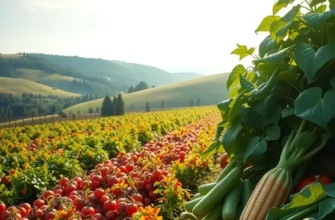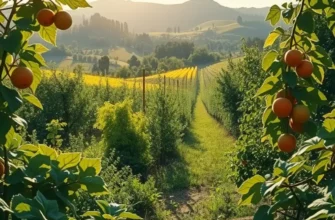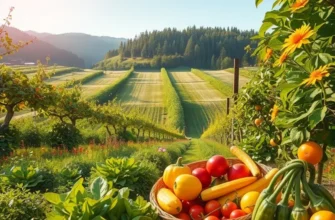Keeping food fresh while minimizing waste is a goal for many households. Natural methods can be surprisingly effective in extending the life of your perishables. This guide explores straightforward food storage techniques, ensuring you enjoy vibrant flavors while promoting sustainability. From understanding the right storage conditions to simple preservation methods, practical tips await to elevate your food management game.
Optimal Food Storage Techniques

To maximize freshness and nutrient retention, understanding the specific needs of various food types is crucial. By utilizing natural storage techniques, you can extend the life of your produce, dairy, and pantry staples while minimizing waste.
Fruits and Vegetables
Proper storage of fruits and vegetables starts with knowing their ethylene production and sensitivity. Ethylene is a natural plant hormone that affects ripening. For instance, bananas, apples, and tomatoes release high levels of ethylene. To prevent premature spoilage, store ethylene-producing fruits separately from sensitive items such as leafy greens and berries. Most vegetables and fruits retain their freshness longer when stored in the refrigerator. However, staples like potatoes, onions, and garlic fare better in a cool, dark place away from direct light. Maintaining slight humidity through a damp paper towel can help extend the life of greens like lettuce and spinach.
Dairy Products
For dairy, maintaining a consistent cold temperature is essential. Store milk on the refrigerator shelves rather than the door, where the temperature fluctuates most. Cheese benefits from being wrapped in wax paper rather than plastic, allowing it to breathe and slowing down mold growth. Yogurt and sour cream require secure lids to prevent the absorption of odors from other foods.
Grains and Legumes
Grains and legumes thrive in airtight containers, protecting them from pests and moisture. Storing these items in dark and dry environments preserves their natural oils, extending their shelf life. Whole grains have a shorter lifespan due to oil content, so refrigeration or freezing is recommended for long-term storage.
Herbs and Aromatics
Herbs like parsley and cilantro last longer when placed stem-down in a jar of water, covered loosely with a plastic bag, and stored in the fridge. Hardy herbs such as rosemary and thyme can be preserved more effectively by wrapping in a damp cloth or freezing them in olive oil within ice cube trays.
For further strategies on eco-smart storage to complement these techniques, explore this guide on eco-friendly kitchen storage.
Using these methods not only supports sustainability by reducing waste but also ensures you enjoy the nutritional benefits of your food for as long as possible.
Natural Preservation Methods

Preserving food naturally not only extends its lifespan but also enhances its flavors. From ancient times, people have harnessed methods like canning, pickling, and drying to maintain food quality and safety. Each technique offers unique benefits and is suited to different types of foods.
Canning is a method that involves placing foods in jars or cans and heating them to a temperature that destroys microorganisms and inactivates enzymes. This method is particularly effective for fruits, tomatoes, and other high-acid foods. By depriving bacteria of the oxygen they need to thrive, canning locks in freshness and flavor. It’s a science as much as an art, requiring precise timing and temperature to ensure safety and flavor retention.
Pickling is another time-honored preservation technique that both extends shelf life and adds a distinctive tang to foods. This method involves immersing food in an acidic solution, often vinegar, which creates an inhospitable environment for harmful bacteria. Not only does pickling preserve produce, such as cucumbers and onions, but it also transforms flavors, adding depth and complexity. Spices like dill and mustard seeds can be added to tailor the taste, allowing for delicious variety and personalization.
Drying removes moisture from foods, creating an environment unsuitable for the growth of germs. This method works well for fruits, vegetables, and herbs. Modern techniques include oven and dehydrator drying, which provide consistent results. Traditional sun drying can also be remarkably effective when conditions are ideal. Dried fruits make for convenient snacks, while dried herbs add concentrated flavor to dishes. The reduced weight and volume of dried foods make them easy to store for extended periods.
Each of these techniques complements natural food properties. They can be combined with practical ingredient batching [https://holdmycarbs.com/nutrihub/meal-planning-meal-prep/practical-ingredient-batching/] to maximize efficiency and minimize waste. By understanding the fundamental processes of natural preservation, one can enjoy seasonal flavors year-round and contribute to reducing food waste through thoughtful storage strategies.
Ultimately, embracing natural preservation methods encourages a deeper connection with food and promotes a more sustainable approach to consumption. By extending the freshness of food naturally, we celebrate its original flavors while fostering culinary creativity.
Final words
Harnessing the power of natural methods not only extends the freshness of your food but also supports a sustainable lifestyle. By incorporating better storage techniques and preservation methods into your routine, you can reduce food waste and enjoy delightful, vibrant meals. The journey towards improved food management begins with simple changes—embrace these practices for a more fruitful kitchen experience. Remember, fresh is not just a state of being; it’s a conscious effort that pays off every time you enjoy a meal.







